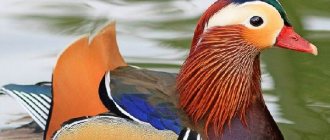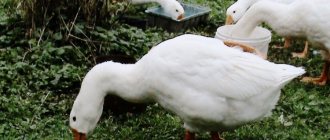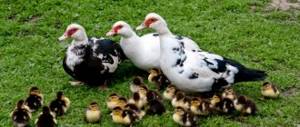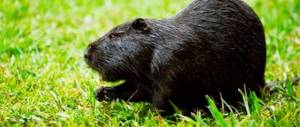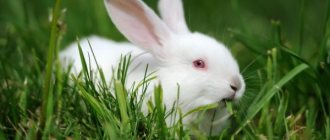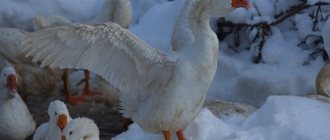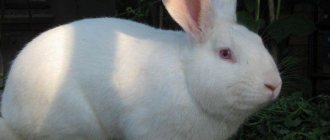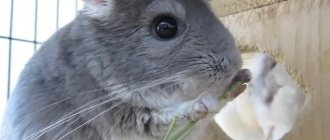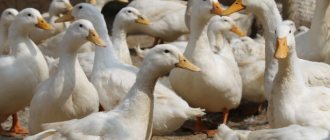Description
Wild Indian ducks are dark in color with a few white feathers. Domestic breeds can have different colors.
- Black Indian ducks have a completely black color, the back and wings have a green tint, the rest of the body is purple. The down is dark gray, the beak and paws are black, and the eyes are brown.
- The brown duck has chocolate brown plumage. In this case, there may be individual white spots on the body, the wings and neck may have a dark, almost black, tint.
- Walnut-colored Indian ducks differ from the previous variety by having lighter colored plumage. It may have white spots and darker feathers on the tips of the wings and on the neck.
- Bluebirds have a pronounced blue color throughout the body, but individual feathers stand out with their dark edging. Beak and paws are black
- White Indian ducks have snow-white plumage, without a hint of yellow. The beak is pale pink, the legs are yellow. The eyes are gray with a blue tint.
- White with a black spot on the head - they differ from the previous variety only in the presence of a spot.
A distinctive feature of the Muscovy duck's appearance is the fleshy growths on its head, which are also called corals and warts. They are located above the beak and in the eye area.
Because of these growths, some believe that turkey ducks were the result of crossing ducks with turkeys, but this is not so - these two varieties of birds cannot give birth.
The Muscovy duck lays from 8 to 14 eggs, which it incubates for 35 days. Ducklings of this breed can have different colors - they are yellow, yellow with black spots, black with yellow spots. The beak color of small Indian ducks ranges from pink to dark, almost black.
This is a meat breed, that is, one of the broiler breeds. Domestic Indian ducks are much larger than wild ones: males reach a weight of 6 kg, females - 3 kg.
Description of the Indian
Another name - musky - comes from the peculiarity of old individuals, the area on the head of which emits musk. Indo-ducks are also called mute ducks because they cannot quack. The wild ancestors of these birds still live in Mexico and South America.
There are several types of domestic Indian duck depending on the color of the plumage: black white-winged, black, white, blue white-winged, brown, hazel, blue. Musks are strikingly different from their “colleagues”. They are larger, drakes weigh up to 7 kg, females - up to 3.5 kg. Therefore, the main focus of the breed is meat. On the head near the beak they have a skin growth or “wart” similar to a turkey earring.
Thanks to their strong wings, Indian ducks are able to fly and love to sit somewhere on the roof of a barn or fence, which looks funny and absurd. Musk meat is tender, lean, and tastes like wild duck. Recommended for dietary nutrition. Eggs contain a lot of protein, B vitamins and microelements.
Advantages of the breed
Muscovy ducks are rarely kept in large poultry farms. However, many farmers breed them in their private farmsteads. The advantages of this breed include:
- very valuable dietary meat with a minimal percentage of fat, reminiscent of broiler meat in taste;
- Muscovy ducks are very quiet and clean, so they cause minimal inconvenience;
- females of this breed have a greater tendency to incubate, thus, they themselves are able to hatch ducklings without human help and special equipment for incubation;
- Muscovy ducks have good egg production and can bear offspring twice a season.
Thus, this breed is well suited to farmers who want ducks that cause a minimum of inconvenience and do not require much attention.
Of all the other breeds, in terms of these qualities, the Mulards are closest to the Indo-duck. These two varieties of poultry are often confused, but they are actually different species.
Growing and care
In order to grow your livestock to productive age and obtain excellent quality meat, you should feed the ducks properly and also take good care of them.
Content
Mulard care is standard for all waterfowl. They require:
- indoor poultry house with an area of 1 m2 for a pair of adults;
- a courtyard (clearing) for walking, where each duck will have 1 m2 of territory;
- a body of water, in the absence of which a large container of water will do. The latter is not mandatory, however, given the nature of ducks, it would be appropriate.
In order for young animals to grow quickly and be healthy, it is important to provide a comfortable microclimate. Chicks need 24-hour lighting. It is gradually reduced, and already from the 11th day the ducklings have enough 16-hour daylight hours. The optimal air temperature in the poultry house is 20-22°C, and next to the heating device - up to 30°C.
The poultry house where the flock lives must have:
- smooth floors, without holes, cracks and missing boards, so that mice and other small predators do not get into the room;
- windproof walls that do not need to be insulated;
- hole on the south side for birds to go out for a walk.
It is recommended to use dry wood shavings, straw, and hay as bedding on the floor, which are laid in a thick layer mixed with fluff lime. Sawdust cannot be used, because if the ducklings eat it, they may die.
The walking yard, like the poultry house, should be protected from rodents. The lack of a natural pond is compensated for by low troughs of water where the Mulards could swim. If the chicks hatched in the warm season, they are released into the yard already on the 4th day.
To prevent birds from suffering from infections, it is necessary:
- move them into a barn that has previously undergone disinfection treatment;
- clean up the poultry house and yard every day;
- change the litter as it gets dirty;
- wash feeders and drinkers, periodically using household antiseptics.
It is easier to protect against infectious pathologies if the birds have been vaccinated. Information about when and what vaccinations to give can be obtained from the territorial veterinary service.
Feeding
It is important to feed meat ducks nutritiously and in a balanced manner so that they grow quickly and gain weight. Chicks, like adults, need diets based on one or more types of grain. Farmers give young animals ready-made mixed feed of the “start” category, and owners of small peasant farmsteads give crushed and steamed grain.
Chickens older than 3 days are given greens, and after the 3rd week - complete wet food, which you can prepare yourself.
Feeding Mulard ducks is no different from other meat breeds. The basis of nutrition consists of such components as:
- millet, corn, barley and wheat - in grain and bran;
- greens, roots and vegetables;
- meat and bone or fish meal;
- vitamin premixes;
- mineral supplements in the form of crushed shells and egg shells. Mulards must drink plenty. With a lack of water, their meat turns out dry and fibrous.
Ducklings are given food 3 to 5 times a day: early in the morning, and then at 3-4 hour intervals. The last portion is poured shortly before sunset, because with the onset of darkness the ducks see poorly, so they settle down to sleep.
Drakes intended to produce delicious liver are fed in a special way:
- For the first 3 weeks of life, chicks are given standard mixtures for ducks. Grown-up Mulards are placed in a separate, cramped cage. There should be so little free space in it that the bird can hardly move.
- For a month, fattening males are given food high in protein and carbohydrates for increased weight gain.
- After this, they are transferred to forced feeding for 3 weeks: food is placed in the throat, and so that it moves through the esophagus, it is pushed with a special device. Every day the drake has to eat 1.8 kg of food in this way. Animal rights activists consider this method of feeding inhumane, but it can significantly increase the size of duck liver.
Before killing a bird, it is kept hungry for several hours and given a minimum amount of water. After slaughter, the carcass is doused with very hot, but not boiling water (up to 80 °C). This will allow you to quickly remove fluff and feathers from it, as well as give it a marketable appearance.
Breeding
It is impossible for Mulards to produce offspring “in themselves” - females give unfertilized eggs, despite the active sexual behavior of the drakes. As before, to breed this cross, they practice mating musk males and white “Peking” females.
The drake and several females are placed in a separate pen or room, but this does not guarantee results. A “gentleman” in black and white clothes may show indifference to “ladies” with snow-white plumage. Knowing this, poultry farmers draw strokes of dark paint on the backs of the females in advance so that the drake accepts them as his own. The offspring will be strong and highly productive if the best individuals aged 7 to 10 months are taken as parents.
This technology is not very convenient for owners of small peasant farms. It is easier to use eggs from a poultry farm and then warm them through an incubator. Average price for 1 piece. Russian production is 80 rubles, and French from 100 rubles. It’s even better to buy ready-made Mulard ducklings, the cost of which is 2-3 times higher. This is a lot, but it is profitable, since the profitability of maintaining a French hybrid is up to 70%.
If there is no incubator, you can entrust the incubation of eggs to a duck of another breed, or to a brood hen. First, in a quiet place in the house, you should place a nest box covered with soft straw.
An adult medium-sized duck can take custody of 10 to 15 eggs. In order not to make mistakes with the material, they take only those that were released no later than 7 days ago. On the 10th day, the eggs are checked with an ovoscope for the presence of an embryo. “Single” ones are rejected and immediately removed from the nest.
The duck will not leave the nest for a long time if bowls of food and water are placed nearby. It is also important for the bird to be able to bathe from time to time because the eggs need to be moistened. When incubation occurs artificially, the eggs are sprayed with water manually.
Ducklings are born within a month. Thanks to their excellent appetite, they grow rapidly and become stronger. When caring for young animals, it is important not to forget about vaccination. This will help minimize livestock losses from disease.
Crossing with other breeds
Indo-ducks can be crossed with other breeds. Drakes are used for this. Mulard is a hybrid breed that is obtained by crossing male Indian ducks with female Peking white ducks, Rouen ducks, Orpington ducks and White Allier ducks.
Mulards are significantly superior to indo-ducks in many qualities - they grow faster, reach sexual maturity earlier, are less demanding of heat and have greater mass.
However, in some respects this breed is inferior to the Indian duck. Mulard meat is considered less valuable due to its higher percentage of fat. also noisier and unclean, and their brooding instinct is less developed.
Thus, in terms of the totality of their qualities, mulards represent an intermediate option, a kind of golden mean between indo-ducks and ordinary domestic ducks descended from the mallard.
Distinctive features
Indo-ducks are often confused with representatives of other breeds. But in fact, distinguishing them is not difficult.
The main difference between the musk duck and the mulard is the presence of fleshy growths on the head. The latter has a growth on its beak, reminiscent of the growth on the beak of a Muscovy duck, but it is much smaller in size. Both breeds have long tails.
The musky duck can also be distinguished from the Peking duck by the presence of growths above the beak and in the eye area.
In addition, the difference in the orientation of the body is clearly visible - in Indo ducks it is located horizontally, parallel to the ground, while the body of the Peking duck is raised at an angle of about 30 degrees.
In addition, indo-ducks have longer wings and tail.
Crossbreeding with birds of other species
Contrary to popular belief, ducks cannot be crossed with birds of other species. Just as some consider the turkey duck to be a cross between a duck and a turkey due to the fleshy growths located on its head, others think that the mulard is obtained by crossing it with a goose. But that's not true.
Ducks and geese cannot give birth. Even if the female lays an egg, it will be unfertilized.
In the markets you can sometimes find scammers offering chicks with assurances that they are a hybrid breed that will grow into a duck weighing more than 6 kilograms, but you should not believe them.
The Muscovy duck is a breed that is well suited for keeping in a small backyard. It is clean and very quiet, so it creates a minimum of inconvenience. Its meat is much less fatty than that of ordinary ducks, which descended from the mallard. But you need to be prepared for the fact that it gains weight more slowly and does not reach the size that is typical for ducks of other breeds.
Let's get acquainted with some of the breeds of domestic meat ducks . It should be noted that ducks are a bird with strong immunity to diseases and unpretentiousness, very common in the household. Each breed of domestic duck has its own characteristics, but I would allow myself to classify them into three main groups:
The most popular among poultry farmers are meat breeds of ducks , the main advantages of which should be highlighted:
- high fertility
- precocity
- excellent vitality
- high taste qualities
I’ll start the description of duck breeds belonging to the meat type with the fact that ducks of this type of poultry farming are large in size and weight. Abundant feeding of ducklings and good care for them allow them to gain up to 2.5 kg of high-grade meat at the age of 50-60 days with a live weight of ducks of 3.5-4.5 kg.
Don't delay. Let's look at 4 of the most popular breeds of meat domestic ducks, which are raised by poultry farmers. These are Peking ducks, Bashkir ducks, Mulard ducks and Muscovy ducks.
Features of keeping hybrids
For inexperienced birders, Mularda ducks are considered a godsend. Crosses are growing quickly. The bird can be fed with store-bought feed if there is no concept of preparing grain mixtures yourself. It is enough to include greens and vegetables in your diet. The following conditions are recommended for successful duck rearing:
- stable temperature in the barn – from 16 to 25°C;
- humidity around 60-70%;
- in the cold season, the presence of peat, straw or sawdust on the floor;
- inside the barn, 1 m2 of space is allocated to 3 individuals, and in the aviary - to 2 ducks;
- prevent the formation of dampness, dirt, and drafts inside the poultry house.
Mulards do not tolerate cold well. As the temperature drops below normal, the bird huddles in a corner, loses weight, and gets sick.
Feeding ration
According to the classical scheme, ducks are fed 2-3 times a day. However, Mulard is a hybrid. In reviews, poultry farmers claim that food can be constantly present in the feeder. Due to intensive feeding, the bird reduces activity. The gain of muscle mass is accelerated, just as it happens in broiler chickens.
The main diet of ducks consists of crushed grain. Variety is welcome: wheat, barley, corn. Grain mixtures are enriched with cake, grated zucchini, boiled potatoes, and carrots. If there is a river nearby, it is useful for the bird to catch algae and duckweed.
Crosses gain weight faster when they receive properly balanced food. It's difficult to prepare it at home. It is not always possible to obtain all the necessary components or calculate the required proportions. It is easier to feed Mulards with store-bought feed. Young birds are given a starter type of feed, and older birds are given a finishing type of feed.
Fattening crosses on foie gras is popular. The diet remains the same, only the bird’s activity is limited to the maximum. Three-month-old individuals weighing 4 kg or more are usually selected and placed in cages. Food is always present in the feeders. More often, mash is forced into the bird's stomach through special devices. Ducks sleep more, the body becomes overgrown with fat, and the liver increases in size. When heavy breathing occurs, the beak turns pale, and the eyes become sunken, this signals the need for slaughter.
With normal maintenance and for foie gras, Mulard ducks are not suitable for slaughter before three months. The young bird builds muscle mass during this period. The absence of a fat layer affects the deterioration of the quality of meat. Crosses four months old with a minimum weight of 3.5 kg are suitable for slaughter. Within a couple of hours they stop feeding the bird. A slaughtered duck carcass is scalded with hot water, after which the feathers are easily plucked.
Peking ducks
are the most popular among other duck breeds. The homeland of this subspecies is China, where they appeared about three hundred years ago.
The appearance of Peking ducks is quite remarkable - a raised long body, a wide and deep chest, a long and wide back. The beak is yellow-orange in color, slightly concave and medium in size.
The bird's legs are small, but thick, with a red-orange tint, located closer to the rear surface of the body. The eyes are large, shiny, set very deep, and have a dark blue tint.
Positive characteristics of Peking ducks:
- omnivorous
- precocity
- quick set of meat
- cold resistance
- unpretentiousness
Young Peking ducks gain weight quite quickly. Adults weigh 3.6-4.1 kilograms , and good egg production occurs in the first 2-3 years of life.
As a rule, Peking ducklings are obtained by incubation, since maternal instinct is poorly developed in females of this breed.
Ducks are omnivores and happily consume food of animal and plant origin.
Disadvantages of Peking ducks:
- noisy
- fatty meat
- overly gluttonous
- increased excitability
Description and characteristics of mulards
Adult ducks reach a weight of 7 kilograms. Females grow 0.5 kg less than males. With dense feeding, the birds' weight increases over the weeks. In 2 months, a duck can be fattened by 2 kilograms. Table of weight gain in birds by month:
| Bird age | Bird weight |
| By 3 months | About 4 kilograms |
| After 6 months | More than 4 kilograms |
| By 1 year | 7 kilograms |
Mulards look like large Peking ducks. They have snow-white plumage; there is often a black spot on the head, which indicates that they belong to the breed. The feature that distinguishes Mulards from Pekings is the rapid gain of muscle mass. Peking women gain fat, but their muscle mass remains the same.
The body of the standard Mulard duck is large, with wings tightly pressed to the sides. The bird moves slowly, calmly, does not get into fights with neighbors, and does not provoke other birds. Females are known for their cleanliness, but their brooding instinct is almost undeveloped.
Expert opinion
Zarechny Maxim Valerievich
Agronomist with 12 years of experience. Our best country expert.
Ask a Question
Compared to Peking birds, Mulards are distinguished by their calm disposition and quietness; they are not loud, do not hiss at their neighbors like mute birds, and do not wake them up with screams in the morning like Spanish or Dutch birds. Mulards are capable of calmly walking for whole days, looking for juicy grass and drink.
Birds that develop dark feathers in their tail plumage are called mulattoes. This means that mistakes were made when crossing along the parental line. Experienced breeders strive to purchase birds with white plumage and a black spot on the head.
Ducks of the Bashkir breed
known for its excellent meat performance, unpretentiousness, frost resistance and high productivity, as well as disease resistance.
This subspecies of meat ducks includes the Black White-breasted Bashkir duck and the Khaki Bashkir duck . Distinctive features of Bashkir ducks, which make it easy to recognize them, are:
- large and widely spaced muscular paws
- wide concave beak
- flattened head
The homeland of Bashkir ducks is Bashkortostan. It was there, at the Blagovarsky breeding plant, as a result of ongoing selection work, that ducks with a very unusual color appeared quite by accident.
The new breed of ducks turned out to be resistant to most diseases and had high productivity.
The live weight of the Bashkirka is 3.5 - 4 kg. Duck meat is quite tender and without a specific smell, but fatty.
But since I touched on the topic of the taste of meat, I most like the meat below the listed breeds. Mularda and Muscovy duck breeds.
The positive characteristics and disadvantages of the Bashkir duck breed are approximately the same as those of the Peking duck breed, which is presented above.
Comparative characteristics of ducks, which breed is better
To determine the superiority of each breed, it is necessary to compare their basic qualities. Based on the results obtained, it is easier to decide which ducks to give preference to. To make it easier to review, the characteristics are placed in a table.
| Parameter under study | Mulard | Indian |
| Meat yield from carcass | 70% | 50% |
| Taste qualities of meat | Red meat tastes like beef. The product is tender, juicy, without a specific smell. There is a thin layer of fat. The bulk of the fat is collected under the skin. | Red meat tastes like game. The absence of fat allows it to be used for dietary nutrition. The meat is aromatic, but due to the lack of fat content in some dishes, it is low in juiciness. |
| Fat content | Slightly fatty meat, but it all depends on the feeding. | Lean meat. |
| Useful properties of meat | Cholesterol content is low. The meat is rich in protein, minerals, vitamins A and B. | Meat has a high content of protein, fatty acids, minerals and vitamins of all groups from A to K. |
| Harmful properties of meat | It should not be used by people with gastrointestinal and kidney diseases. | Contraindicated for people suffering from obesity, gastrointestinal tract disease, kidney disease. It is not recommended for use if the blood cholesterol level is high. |
| Egg production indicator | Up to 250 eggs per year, but they are not fertilized. | Up to 100 fertilized eggs per year. |
| Approximate egg weight | 90 | 80 |
| Useful qualities of eggs | A nutritious product used for baking and cooking. | The nutritious product is rich in phosphorus, magnesium, calcium and other vitamins. |
| Possible harm from eggs | Cannot be consumed raw. You can get severe poisoning and salmonellosis. | The product is contraindicated for pregnant women, children, people with gastrointestinal diseases and allergies. |
Mulardy ducks
are an interspecific hybrid obtained by crossing musk drakes and domestic ducks, in particular with the Peking duck.
This type of duck is excellent for home breeding and industrial fattening. They are simply ideal for industrial fattening, since the liver of this duck, like the liver of a goose, can be used for such unique food as Foie gras.
Mulard meat can be compared in its characteristics to goose meat, which takes much more time to fatten.
Mulards are unpretentious in food and can gain weight well even on grass, which they eat just like geese, without special “duck” food.
They gain weight a little longer than Peking ducks and reach four kilograms in three months.
The main positive characteristics of Mulardy ducks:
- cleanliness
- calm character
- precocity
- large live weight
- quality meat
Mulards are sterile, have good health and adapt well to environmental conditions. They can be released into the pond at the age of one month. It is impossible to meet them in the wild, as they are an artificially bred breed.
This breed of duck is ideal for those people who do not welcome fatty poultry meat. Mulard's fat content can be as low as 3%.
Other characteristics of the meat of such a duck can easily be compared with goose meat, however, the fattening time of geese can be up to 8 months, and the fattening period of such a duck is only 4 months.
Disadvantages of Mulardy breed ducks: with such qualities, I would like more mass of the duck. (5-6 kilograms). We have a separate article .
What is a mulard duck?
Mulard is a cross between a domestic Peking duck and a Muscovy duck. They resort to this in order to minimize the disadvantages of natural breeds of ducks and obtain the desired product. We reviewed the description of the Peking duck and several others earlier.
Peking ducks quickly become sexually mature, are fertile, tolerate our climate well and withstand cold weather.
However, they are prone to the accumulation of fat mass, which means they are less productive from an economic point of view. Besides, Beijing is noisy.
The Muscovy duck is cleaner and quieter. She accumulates high-quality muscle tissue, but female Muscovy ducks gain very little live weight, only about 1 kg. They grow slowly, mature late, have complex cycles of laying and incubating eggs, moreover, they are heat-loving and capricious to cold weather.
Mulard ducks: a cross that is in demand
Mulards are a solution to the listed economic problems. They are neat and calm. They gain weight quickly, reaching 1.3-1.5 kg in 7-10 weeks.
In 3 months - up to 4 kg, and if kept longer - up to 5 kg of live weight. They give good meat and liver. Today, it is male mullards that are used to produce the delicacy foie gras; previously, geese were bred for this purpose.
But you need to remember that such ducks are sterile, they are bred only for meat. For independent breeding, you need to get several Beijing females and a musk drake. Or a male Pekingese on several Muscovy ducks. Otherwise, buy young animals.
Mulard ducks do not produce offspring, although in some cases they lay eggs (clutch of 6-7 pieces).
Mulards, like any hybrid, are strong and unpretentious. They can withstand our harsh climate and love fresh greens, which need to be supplemented with corn and animal feed in small quantities.
Such a duck will not consume much more than a Peking duck, but will produce high-quality meat.
During forced fattening, when the ducks are placed in a box, limiting their mobility, and fed generously with corn, the mulards gain 0.5 kg of live weight, including more than 500 g of fatty delicacy liver.
Appearance of ducks of the Mulard breed
Such a duck is not just a profitable purchase for the household, but also a decoration for the yard. They can get all sorts of colors depending on the breeds of their parents.
Most often, mulards are light-colored with a dark spot on the head. They have strong legs and wings that tightly cover the body. Female mulards are slightly smaller than males - only up to half a kilogram.
Muscovy duck breed
It is impossible to imagine meat breeds without the Muscovy duck breed. The Muscovy duck is native to South America and its direct ancestor is the wild Muscovy duck.
Domestic ducks of this breed have retained some of the habits of their wild relatives - they have a wild disposition and love to fly.
I myself have witnessed a musk duck take off more than once at my dacha, so I advise you to trim the wings
Due to their appearance, Muscovy ducks are called warty ducks or Indo ducks. There is an opinion that the Muscovy duck received from the quality of old individuals of this breed to secrete fat in the growth area on the head with the aroma of real musk.
Muscovy ducks have the following positive qualities:
- good endurance
- unpretentiousness and high resistance to various avian diseases
- Musk breed meat contains a small proportion of fat and is distinguished by exquisite tenderness
- quiet (mute) not gluttonous, eat in moderation and little by little
Female Muscovy ducks are excellent brood hens and mothers. In remote villages, where there is no such close attention to the livestock, you can suddenly see a picture of a female Muscovy duck suddenly, from where it is not clear, hatching ducklings and their number can reach 25-30 heads. But this is more typical in the southern regions of the country.
The hatchability of ducklings under a hen is greater than when eggs are incubated. I don’t find any negative qualities and consider them to be the best breed of ducks that we have ever raised. I recommend.
Well, that’s all the main qualities of the Peking, Bashkir, Mularda and Muscovy breeds of ducks. Please write your opinion about the above in the comments and I will be very glad to learn about your duck breeds.
Breeding Indian ducks at home is very easy if you know about all the features of caring for this bird. She is quite unpretentious, but still requires attention. How long it takes to raise a drake or duck depends entirely on the correct nutrition. The presence of sufficient vitamins and minerals in the poultry diet directly affects weight gain.
Description of the breed
Muscovy ducks are native to South and Central America. This species combines the best qualities of geese and ducks. Birds have a medium-sized head. Some coral-colored formations can be seen near the beak of musk birds. The Indian duck's neck is shortened and slightly thick. These birds differ in the color of their feathers:
- with white plumage;
- combination of black and white feathers;
- black body with white wings;
- with brown plumage.
Muscovy ducks have good egg production. One female can lay about a hundred eggs per year. This is quite possible at home if all the rules regarding nutrition and other conditions for raising birds are followed.
The weight of the egg is 80-85 g. The shell is painted white, but has a yellowish tint.
Advantages of the breed
Raising turkey ducks at home has become so popular because of the many benefits that can be obtained by keeping this bird:
- Indian ducks are fairly quiet birds. They do not quack, but hiss;
- high-quality and rigid plumage that protects from frost;
- breeding birds is very simple, since they are not picky about food and living conditions;
- very tasty and fairly lean meat;
- Indo-duck breeding can be carried out both in a closed enclosure and in open areas;
- Muscovy ducks are very caring birds towards their offspring.
How to recognize a male?
The appearance of the drake is very different from the female in many respects. It can be identified by the following characteristic differences:
- near the base of the beak they have a fleshy formation that resembles a cone;
- they have brighter and more magnificent plumage;
- a crest of bright and long feathers is placed on the neck;
- the tip of the male's tail has curled feathers;
- the weight of drakes is much higher than that of female birds;
- all parts of the male’s body are longer and more massive;
- the presence of a pseudopenis when examining the anus.
It is worth noting that drakes are more hardy and less susceptible to various diseases than female birds.
For 3-4 ducks, only one male should be left. If this rule is not followed, it will be very difficult to obtain high-quality offspring. If you decide to keep poultry exclusively for meat, then it is recommended to increase the number of drakes.
The taste of meat and its beneficial properties
Indo duck meat has high taste qualities. At the same time, it is dietary. Indo-duck meat contains only 30-37% fat, which is much lower than other varieties of poultry.
The weight of the drake brisket reaches 800 g, which exceeds that of an ordinary duck. Females have less meat. The weight of turkey breast is 350-400 g.
The meat of this bird is to the taste of many. It even vaguely resembles game.
If you include turkey meat in your diet, you can get the following benefits:
- due to its high protein content, it is suitable for the diet of athletes;
- the optimal ratio of beneficial amino acids, the presence of unsaturated fatty acids, vitamins and microelements has a general strengthening effect on the human body;
- Due to its low cholesterol content, it is indicated for people who suffer from atherosclerosis and cardiovascular diseases.
Bird care
Keeping these unique ducks is possible under certain conditions:
- For birds, bedding should be changed regularly as needed. You can use straw or sawdust for this;
- raising birds is possible only in conditions of low humidity;
- It is prohibited to breed Indian ducks in a cramped enclosure. It is important to create conditions under which birds can move actively, which will contribute to good weight gain. For 1 sq. m there can be no more than three individuals;
- Indo-ducks can only be kept in a room with good ventilation.
Indo-ducks still have the instinct to fly. If you decide to breed this bird at home, do not forget to trim its wings regularly.
How many times do you need to do this to avoid trouble? The duck quickly gets used to the fact that it cannot fly, so it is often enough to trim one wing only once. In some cases, this procedure may need to be repeated if the bird tries to take off.
Indo-ducks are released for walking no earlier than 10 am. This is due to the fact that birds lay eggs very early.
If you want to keep these ducks, you need to provide them with access to open water. If this is not possible, then build small grooves or water containers yourself.
Bird food
These ducks reproduce well at home. If you breed them, it is important to provide them with high-quality nutrition, which must include:
- grain feed - wheat, oats, corn, barley, millet and others;
- a variety of root vegetables, both raw and boiled - potatoes, beets, carrots;
- fresh herbs;
- mineral feed - chalk, ash, egg shells, fine gravel, table salt;
- factory-produced feed;
- meat and fish waste, including bone meal;
- whey or yogurt.
How much food does one duck eat? On average, a bird needs 300-350 g of food and at least a liter of water per day. It is best to make food in the form of a mash using whey or meat broth.
Bird breeding
Raising indo-ducks is not a difficult task at all, since these birds lay eggs well and carefully care for their offspring. Keeping one male for 3-4 females, who must be at least 1.5-2 months older, will allow you to get a good offspring.
Indian ducks begin laying eggs in early April. In order for young ducks up to six months old to start laying eggs on time, you need to gradually increase daylight hours to 16-14 hours a day. It is important to maintain this value for several more months.
When at least a dozen eggs have accumulated in the nest, the duck will sit down to hatch them. For the bird, you need to first prepare a nest. Make this from a regular cardboard box, which you cover with fabric made from natural fibers. When the bird sits in the nest for 2-3 days, you can lay the required number of eggs.
The maintenance of the female, which hatches the offspring, should take place in comfortable conditions.
Be sure to place a drinking bowl and feeder next to the nest. Also place a container of water so that the bird can bathe. A brood of ducklings appears already at 33-35 days.
One female is capable of incubating eggs 2-3 times per season. At the same time, 20-23 individuals per brood are born.
Description of the breed
The Mulards have collected all the positive qualities of their ancestors. They are distinguished from simple ducks by their cleanliness and calmer disposition. Do they fly like musk ducks - yes, but you shouldn’t clip their wings, since their massiveness prevents them from displaying their flight abilities.
Characteristics of appearance
The birds are large, with a long body, the wings fit tightly. Medium-sized head with dark eyes and yellow beak, long neck. Yellow short legs, small tail. Comparing hybrid individuals with relatives of the musk breed, it is worth noting the smaller body size and smaller growth on the beak, the paws are also shorter.
Color
There are color variations in the color of mulards:
| Color | Description |
| White | The entire body is covered with a single-colored light feather with a black spot on the head. |
| White black | Predominantly light plumage with dark spots on the head, wings and tail |
| White-brown | Light body combined with dark plumage of the head, wings and tail |
Weight and dimensions
Already at 3 months, the duck reaches a weight of 4 kg, which is considered the optimal slaughter weight; with longer rearing, the figure for an adult increases to 7 kg.
Important! 2 weeks before slaughter, birds are switched to a different menu, excluding fishmeal from the diet. This will prevent the meat from smelling unpleasantly.
Lifespan
When approaching the issue of slaughter, it is important to know how long the mullards take to grow: from 1 to 3 months, ducks actively gain muscle mass, with virtually no fat deposits. Based on this, it is clear when to cut a bird
Keeping it for more than the specified period is not advisable, as molting and weight loss begin
Keeping it for more than the specified period is not advisable, as molting and weight loss begin.
On average, the maximum lifespan is about 10–15 years, but hybrids are often used for industrial cultivation and slaughtered long before that. Before killing, they spend several hours of fasting with free access to water. The ducks are chopped and then scalded with hot water to remove feathers.
Having considered the question of at what age and in what month it is recommended to slaughter livestock, let's move on to the next point - sexual dimorphism of mulards.
How to distinguish a drake from a duck
As with musk ducks, sexual differences are weakly expressed.
You can distinguish a male from a female by the following characteristics:
- External signs. The utak is characterized by a more saturated color of plumage; a growth forms on the top of their nose. As for the females, their heads are more rounded, their necks are short and graceful, and their bodies are narrower. The shape of the tail also varies: males have rounded feathers at the end, while ducks have straight lines.
- Features of behavior. In a flock of ducks, the ducks are always in front, and the males stay to the side or behind. It is worth noting the more aggressive behavior of drakes. Females are identified by quacking, and males by whistling and hissing.
- The structure of the reproductive system. Drakes have a fold 3-4 mm thick in the cloaca area, the so-called pseudopenis.
Also learn about the peculiarities of breeding such popular breeds of ducks as Blue Favorite, Star 53, Indian Runner, Bashkir, Agidel, and Peking.
Productive qualities
The main direction of raising ducks is to obtain meat, ensured by early sexual maturity and rapid gain of live weight.
Egg production
Whether ducks lay eggs or not is a frequently asked question among beginning farmers, and the answer is a clear yes. Mulards have inherited early maturity from their Beijing relatives and begin laying eggs from 7–7.5 months of age. About 210 pieces are demolished per year. The nutritional value is no worse than chicken and is used in cooking.
Important! They are contraindicated for consumption in their raw form due to the high risk of salmonellosis infection.
Meat quality
Mulards are a broiler breed; they quickly gain weight, without excess fat deposits, up to 3% of the carcass weight. The meat has high taste qualities: tender, nutritious, without a specific smell or taste. Due to its low fat content, it is recommended to include it in the menu for children.
The calorie content and nutritional value of meat are shown in the table:
| Index | Quantity |
| Squirrels | 19.7 g |
| Giry | 18.8 g |
| Carbohydrates | 0.94 g |
| Calorie content | 248 kcal |
Did you know? Unlike adults, duck meat contains more copper, phosphorus, aluminum, cobalt, silicon, magnesium and sodium.
Pros and cons of the breed
To fully characterize the hybrid, it is important to approach the review comprehensively, studying all the positive and negative features of mulards
- Advantages:
- calm type of behavior;
- cleanliness;
- rapid growth and weight gain;
- high nutritional quality of meat;
- fast adaptation.
- Flaws:
- sensitivity to high humidity;
- sterility.
